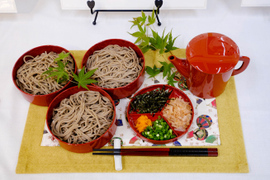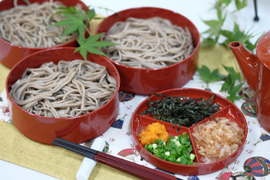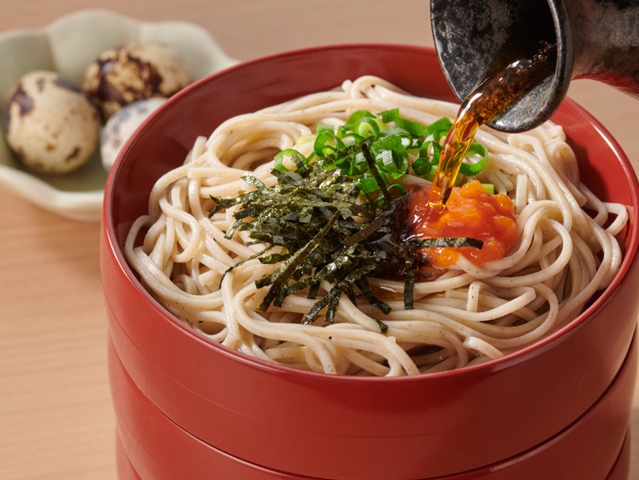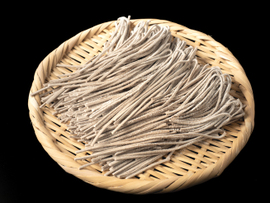
Izumo Soba

ShimaneIzumo Soba
Classification (Large)
Agricultural products
Classification (Small)
Grain products
Main ingredients used
buckwheat
When using downloaded images, please read the "Terms of Use" and clearly state that the source of the image is "Traditional Foods in Japan" by the Ministry of Agriculture, Forestry and Fisheries.
If the photo credits is stated, please include it as well.
Example of description
of the photo credits
Example of description when the photo credits is not stated
Source: "Traditional Foods in Japan" Ministry of Agriculture, Forestry and Fisheries
Example of description when the photo credits is stated
Source: "Traditional Foods in Japan" Ministry of Agriculture, Forestry and Fisheries
Photo credits:xxx
 This image is
This image isunavailable.
 This image is
This image isunavailable.
Region of inheritance
The Izumo region (Izumo City, Matsue City)
Product overview (special characteristics and types)
Along with Iwate Prefecture’s Wanko soba and Nagano Prefecture’s Togakushi soba, Izumo soba is one of Japan’s three great buckwheat soba dishes. Izumo soba is made using a milling method called hikigurumi, in which hulled soba seeds are ground as they are. It is said that this method produces nutritious and highly fragrant soba with an excellent flavor and texture. Another characteristic of this type of soba is that the flour used for binding is amounts to only approximately 20% of the flour included in the noodles. The main ways to eat Izumo soba are cold Warigo soba and hot Kamaage soba, in which soba sauce is directly poured on to the noodles when eating.
Soba is best cultivated in cold climates such as mountainous areas. Shimane Prefecture, which is surrounded by mountains, is famous as a place where people can enjoy soba rooted in the local climate of each region. Some examples of popular soba dishes only found in this prefecture is the light-colored, smooth Sanbe soba, made with soba flour nurtured by the volcanic ash soil of Mt. Sanbe and husked as much as possible. Another example is Oki soba, made from only soba flour and water and traditionally served at ceremonial events such as weddings and funerals on the Oki Islands.
History and culture
Although soba had been grown since ancient times, it was mostly eaten as soba dumplings and soba cake with fillings. It is said that when Matsudaira Naomasa arrived from the Matsumoto Domain’s Shinano Province to take his post as the lord of Matsue Domain’s Izumo Province. he brought along a soba maker from Shinano and they introduced soba-kiri, which is soba kneaded, flattened, and cut into thin strips.
In contrast to Warigo soba, which originated from the castle town of Matsue, it is said that Kamaage soba originated from shrines, including the Izumo Taisha Shrine. Shrines in the Izumo region hold the Kamiari Festival in October of the lunar calendar, which is a time when gods from all over Japan gather together. It is said that in the past, food stalls opened around the shrines during the festival, and hot Kamaage soba made from freshly harvested soba was served.
Production method
When making soba flour, hulled soba seeds are usually categorized from first to fourth flours, and the type of soba flour used has a major impact on the flavor and texture of the noodles. However, with Izumo soba there is no such classification of the buckwheat flour. Instead, it involves a milling method called hikigurumi, in which hulled soba seeds are ground as they are. There are many soba shops in the Izumo region, and each one has its own flair and specialty, enabling people to enjoy the diverse regional flavors of Izumo soba.
Conservation and succession efforts
At the Kamiarizuki Izumo National Soba Festival held in Izumo City in 2001, the Izumo Soba Trade Cooperation Council (now the Izumo Soba Merchants Association) was established with the aim of lifting Izumo soba to national prominence. The organization communicates information, holds events, and also runs activities to pass down this food culture, such as holding soba-making workshops.
Furthermore, February 11th, the day on which Naomasa Matsudaira (who was said to have introduced Izumo soba) was given his order to transfer from the Matsumoto Domain to the Matsue Domain, was registered as the commemorative Izumo Soba Day in 2022.
Main consumption method
The typical ways of eating Izumo soba are Warigo soba, born in the castle town of Matsue, and Kamaage Soba, which was served in shrines such as Izumo Taisha Shrine.
For Warigo soba, cold noodles are served in lacquered bowls. Three bowls are stacked in tiers to make for one meal served in order with seaweed, green onions, grated daikon radish and chili, and dried bonito, with soba sauce poured over the noodles. The leftover condiments and sauce are poured into the lower bowls as you proceed to eat. For Kamaage soba, the soba noodles are served in a bowl containing the water it was boiled in (sobayu), and soba sauce is poured over the noodles, which float in the thick sobayu, and eaten while adjusting the taste to your preference.
At-home recipes:Izumo soba

Ingredients
Izumo soba
200 g
Thin green spring onion shoots (cut into small pieces)
As needed
Shredded laver
As needed
Quail egg
As needed
Momiji-oroshi (Japanese radish grated with red pepper)
As needed
Wasabi
As needed
Yam
As needed
How to make
Boil Izumo soba according to the recipe on the package.
Put the soba in a dish and garnish with condiments.

